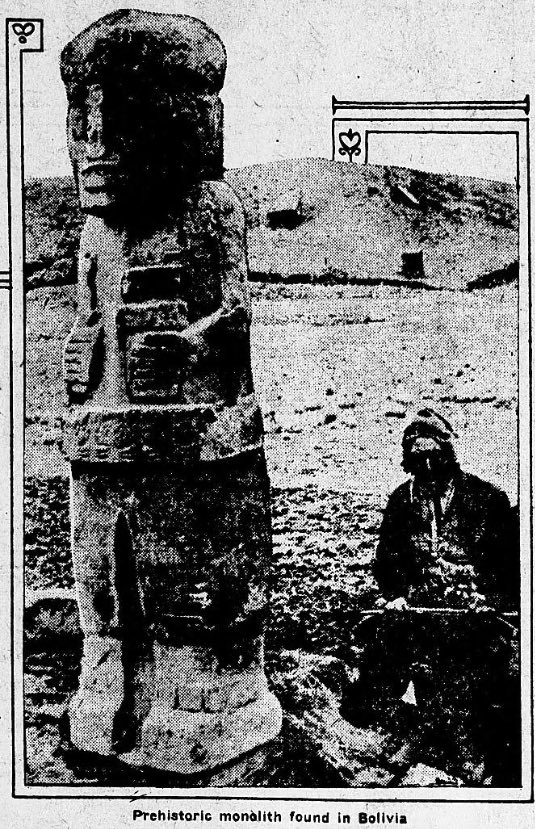
The early 1920s saw a renewed interest in the story of Atlantis, the lost island or continent. There were many different theories being circulated at that time, and each was not only interesting, but also quite plausible.
Will Lost Atlantis Rise Again From the Sea?
Recent exploration of the depths of the sea has furnished undeniable evidence to support the romantic story of Lost Atlantis – the wonderful land which is said to have anciently existed in mid ocean, and which, according to the tale, sank beneath the waves, together with its cities and their inhabitants.

The new oceanographic maps appear to show Atlantis as a now submerged plateau rising abruptly from the bottom of the sea, about 800 miles due west from Gibraltar. At all events, this plateau occupies exactly the place where, according to Plato and other ancient writers, Atlantis was situated. They described it not as a continent, but as a very large island, west of the Pillars of Hercules, which was their name for the Straits of Gibraltar. This description is confirmed by the new maps, which show the plateau to be about 350 miles long and half as wide. Its surface is extremely rugged and mountainous (as proved by soundings), and nine of its highest peaks rise even today the surface of the sea. Their tops form the archipelago of islands known to us as the Azores.
If this idea be accepted, it would seem that Atlantis is not wholly lost. Even now a few summits of its loftiest mountains remain above sea level and afford places of habitation for mankind. The Azores are of Volcanic origin, largely composed of eruptive lavas, and on them are volcanoes not yet extinct, which within recent centuries have belched destructive fires.
All of which perfectly agrees with the story tradition tells – that Atlantis was a very mountainous island, with steep cliffs fronting the ocean along its shores. And the volcanic character of the Azores today rather strikingly suggests a reason for the sudden submergence. Only ninety years ago there was a somewhat similar happening in the Mediterranean, where an island 300 miles in circumference was thrown up from the sea bottom between the southwest coast of Sicily and the ancient site of Carthage on the African coast. after rising to a height of 200 feet it sank and disappeared.
Owing to their volcanic character, the scenery of the Azores is the wildest imaginable. Their most important city, Ponta Delgado, on the island of San Miguel, is located in the crater of a formerly terrible volcano. It is a fashionable watering place, much frequented by wealthy folks from Lisbon (the archipelago being Portuguese territory), partly because of the rocky caldrons of boiling hot water impregnated with sulphur which supply luxurious marble baths. In this connection, by the way, it is worth noting that ancient writers, in their accounts of Atlantis, make special mention of hot spring baths in which the luxury loving inhabitants were wont to indulge.
Fayal, another island of the group, has a volcano with a crater 1800 feet deep. It erupted fiercely in 1672. But the greatest volcano of the Azores is on the island of Pico, a mile and a half high. If, as here supposed, the Azores are submerged portions of the lost Atlantis, that great island must have been in the latitude of Philadelphia and Washington. The archipelago is scattered over a wide expanse of sea, measuring in its utmost length about 300 miles. In its neighborhood are many submerged yet lofty peaks – some of them nearly reaching the surface – which presumably represent mountains of the vanished land.
According to the ancient story, the island called Atlantis was encircled by mountains stretching to the sea. But in the central part was a broad and fertile plain, in which were numerous towns and one magnificent city, with palaces and temples “built of white, black, and red stones.” May this description not refer to black and red lavas and white limestone? Where the sounding line of the marine explorer finds deep water, over the submerged plateau, may have been wide plains, with the cities, palaces, temples, and gardens of which the ancient writers tell.

Compared with Atlantis, the Egypt of the earliest Pharaohs was relatively modern. The city of Babylon was not yet founded when the doomed island sank beneath the sea. For, be it observed, the catastrophe is alleged to have occurred about 9000 years ago. History in Europe and the Mediterranean region does not date back more than 5000 years. For events earlier than the first written records we can refer only to tradition, which is mouth-to-mouth history.
Tradition is our sole authority in the matter of Atlantis and its cataclysmic fate. Yet the extant accounts, derived from the ancient sources, are so definitely circumstantial as to inspire at least some measure of credence. And, in the light, of the recent scientific study here reviewed, it must be admitted that the wonder story has evidence of a very substantial kind to back it.
Let us suppose the whole bed of the Atlantic to be emptied of its water and drained dry. It will then be seen that through it extend from north to south two enormous valleys parallel with the two shores an separated by a broad ridge running down the middle. The ridge curves in an S shape, like the valleys and the shores, and its most striking feature is a high plateau, rugged and mountainous, which rises from it just beneath the fortieth parallel of north latitude and west of the Straits of Gibraltar. This is the plateau of which we have been speaking, the supposed lost Atlantis.
The western valley, stretching the full length of the American continent, is the deeper of the two, but in the eastern valley there are many high mountains, some of which rise above the surface of the sea and form the Azores, the Madeiras, the Canaries and the Cape Verde archipelago. This eastern region throughout its length is a great volcanic zone, with volcanoes in abundance. All the peaks that reach the surface emerge therefrom as volcanic islands or bearing volcanoes. Among them are Gough Island, Ascension Island, St. Helena, and Tristan da Cunha, all of which are tops of mountains rising from the great ridge which runs down the middle of the Atlantic’s bottom.
If a line be drawn from Ascension Island to the archipelago of Cape Verde, the place where it crosses the equator will mark the location of a submarine volcano which at intervals is very active, as shown by clouds of steam rising out of the sea. On all the above named islands are many volcanoes still active, while numerous others apparently out of business seem to have extinguished their fires only yesterday.
Among the Mediterranean peoples there survives tradition of an ancient invasion by Atlantians, who came from an island far out in the western ocean, to the west of the Pillars of Hercules. According to the story, it was abruptly checked by the sudden submergence of the country from which the invading army and fleet had started. As the tale is told, the island was destroyed by fire and water. The earth rocked; vast chasms opened; the mountains belched rivers of molten lava and, to complete the catastrophe, a mighty tidal wave swept over the land. In one day and night the thing was finished. Atlantis sank beneath the sea in a cloud of steam.
While it seems beyond a doubt that our American Indians are of Asiatic ancestry, the descendants presumably of tribes which came across by way of the Bering Strait or the Aleutian chain, no such origin can reasonably be ascribed to the highly civilized races which the early Spaniards found established in Mexico, in Central America and in Peru. Where they came from is likely to remain forever a mystery, but they declared that it was from the east. All their traditions pointed to the eastward, and the Aztecs averred that their forebears arrived in Mexico from a country called Atlan.
At the time of the discovery of America there was a city named Atlan at the entrance of the Gulf of Uraba. In the Aztec language Atlan meant “amid the waters.” It is surmised that the Greeks, as well as the Mexicans, may have got the word from the people of Atlantis.
One-third of the Maya language (which even today is the tongue of the natives of the Yucatan peninsula) is said to be pure Greek, and it has many words derived from the Assyrian. Thus it seems more than possible that Atlantis was a source of immigration into America, and that it may have afforded a stopping off place for early European emigrants on their way to the New World.
A traveler wandering through the well night impenetrable forests of Yucatan or elsewhere in Central America is apt suddenly to find himself on a broad, well paved road, over which in places trees many centuries old are growing. Following it, he sees before him the ruins of a vast city of hewn stones, with splendid palaces and temples. The road has been worn deep by the passing of multitudes of feet during bygone ages, but now nobody goes along it unless an occasional ragged native. All is desolation hopeless and profound. The temples and palaces are the homes of the iguana and the centipede.
The ruined pyramids of Yucatan, the architecture and ancient sculptures of Mexico, Bolivia, and Peru, are most strikingly suggestive of Egypt and the Assyria of thirty-five centuries ago. Very likely a similar culture in Atlantis produced buildings and art works of corresponding character. But in whatever light these things are viewed, the obvious inference is that the early civilizations of those parts of America came from the east.
Curiously enough, the ancient books of the Aztecs contain many references to an awful catastrophe which swallowed up a country far out in the ocean toward the east. Probably we should have more definite and satisfactory statements in regard to it if the Spanish priests had not made a business of destroying by fire all of the Mexican historical and other literature on which they could lay hands.
Atlantis is no more. The ocean has swallowed it.
Source: Grand Forks herald. (Grand Forks, N.D.), 03 June 1921.

